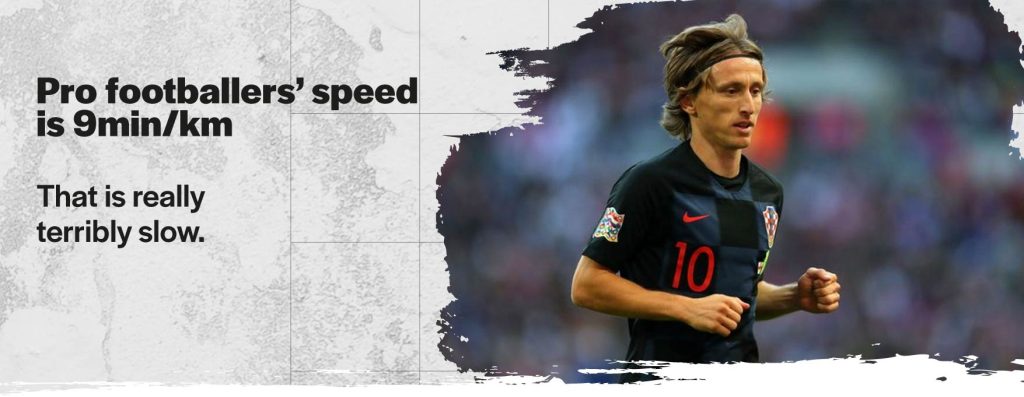Since the first Olympics great runners have been god-like. Leonidas of Rhodes won the race in armour and shield (kitted out in bronze…) as well as flat sprints in several early Olympics. Ageas won a a 3500m race in the morning and ran a bonus 100km (!!!) in the afternoon to go and announce his big win to family and friends*.
Running still establishes our fitness levels.
But let’s look at it from a 21st century perspective.
Does running make you fit?
Running is so valuable because it can be practiced by the vast majority of us. Most of us can one day wake up and decide to take on running. Sure, you might stop after 5 minutes because you are exhausted, but you did run. If that same day you decided to start pole vaulting, you’d still be months of practice away from your first real jump.
Running’s strength lies in its simplicity: it can be easily adapted to short sprints, allowing athletes to work on explosive power; it can be arranged into intervals to work on your anaerobic/lactate system; or the most common form of running, long distance, to burn fat and build a baseline of aerobic endurance. It can be casual, it can be carefully periodised and heavily structured. So the answer is yes. Running can be an instrument to increase part of your fitness.**
Is running overrated?
Do you run to be better at running, or to achieve something else? As a strength and conditioning coach, I cannot stress enough the importance of some accessory strength training and loads and loads of stretching*** if your goal is to run races, but in terms of the “bulk” of your training… well, running is great.
In reality most of us run as conditioning for our favourite sport, usually pitch sports (soccer, football, tennis), or to control weight, or we sprint to get our legs accustomed to short intense power movements sports such as long jump or basketball.
If this is the reason you are running, chances are you are running too much.
Talk to your coach, or with a strength and conditioning coach, or a sport scientist about the right amount and modality of run you need. As a rule of thumb, you don’t need to run too much to be fit for a sport!
Let’s take professional soccer as an example: an elite soccer player covers an average distance of 10km during a 90 minute match. So you can definitely score the 25km routes off your schedule…. Breaking down pro soccer players’ match time, they run 5km in the first half, 15 minutes of rest, then 5km again. That’s a pace of 9min/km, which is, to put it simply, terribly slow.
Remember we are talking about elite players. Perhaps they sprint a lot? Not really: the average pause per player between sprints is around 310 seconds (5 minutes)! So why do you feel so tired when you play football? It is the jumps, the changes of directions, the quick turns, the kicking, awkward movements, tackles, falling, standing up quickly, etc.****
Running in a straight line down the road does not help you here. You need strength and muscular endurance to repeatedly sustain these efforts.
Running tips and technique
Whatever your objective is and your distances, it is always best to do it with the right technique. It is not my aim here to make you the master of running, but here are some tips to make sure you make the most out of it.
For long distances, we need a consistent, efficient, sustainable technique:
- Avoid slouching forward: keep your core, front and back always engaged. You should feel your upper body in a neutral posture, as if you were standing normally.
- Same goes for your head and shoulders. No swinging, no slumping, no tilting.
- Learn to land on your midfoot. If the strike is right on your heel, there won’t be any “elastic recoil” from calves. If you go too much on your toes, you will get tired too soon.*****
If you are sprinting, it’s an all-out burst. No energy saving, only power!
- Lean forward so your core is tight and you are able to engage the big badass muscles at the back of your legs
- Keep your elbows at 90 degrees and use the swing of your arms as much as possible;
- Use short, fast strides, and never ever let your heel of your back leg flick too high!*****
Risks of running
The main risk is overusing joints. A huge misconception about running is that it is gentler on your joints than weight training or impact sports. Wrong! The element that is usually overlooked is the immense number of steps/strikes done while running. Easily over 60/70 per minute, or 4000 per hour. You’re hammering the same exact muscles in exactly the same way for thousands of reps. If there is the tiniest mistake in form, it is multiplied by a factor of hundreds every time you run. Common injuries involve knees and ankles, but a poor running posture can put your lower back at risk too.****** To complete the scenario, a warning: fit people are not immune to this. As any other sport, when you “play” running at a higher level, you play harder and longer, matching your fitness level with the volume of your training. An interesting research estimates over 40% of risk of mild to moderate injury (blisters, ankle sprain, knee pain, tendinopathy), with risk peaks for running athletes under 30 years of age. *******
Does that mean I should not run? No, it means that you should be aware that precisely like any other physical activity, running has its own risks, even if at first sight it doesn’t look as scary as snatching a heavy weight or tackling a muscular rugby player. Just do not underestimate the stress it puts on your joints, and always integrate running as part of a more complete, 360 degrees training program.***
Power and fitness with running
If you are a strength/explosive athlete such as long jumper, hammer thrower, 100m sprint swimmer, etc., short bursts of harder running sessions can be your best ally. How do we make running harder? Well, you could use some kit like a long elastic band or some fancy weighted vests (a bit like the armour run in ancient Greece isn’t it) or… you could keep it simple and run uphill. The steeper the better of course. But I am perhaps going to rock your world now by saying that elite sprinters have used downhill running for years now as part of their training. Why? If you are forced to run faster than you are comfortable with, it teaches your nervous system to manage a faster leg speed. It is a little advanced, but you can give it a try!
Before concluding, I’ll leave you with a couple of running-based workouts that you can do at home to work on your fitness and to challenge yourself a little. If you want to simulate a game condition run, try this:
WORKOUT 1
400m as fast as you can, followed by 40 squat jumps
1 minute rest
300m as fast as you can, 30 squat jumps
1 minute rest
200m as fast as you can, 20 squat jumps
1 minute rest
100m as fast as you can, 10 squat jumps
1 minute rest
2Km jog at an easy pace.
WORKOUT 2
With a stopwatch set to beep every minute, run for km, but every minute stop and complete 5 burpees. Let’s see how long it takes!
References
*IOC (2021) ‘Ancient Olympic games – Running’ [online] available from: https://olympics.com/ioc/ancient-olympic-games/running
** Ratamess, N. (2012) Foundations of Strength training and Conditioning. Indianapolis: Lippincott, Williams and Wilkins
***Ogawa, T., Fukano, M., Fukubayashi, T. (2015) Sports injuries and prevention. 1st edition. Saitama: Springer.
****Andrzejewski M., Chumra J., Pluta B., Konarski J. M. (2015) ‘Sprinting activities and distance covered by top level Europa league soccer players.’ International Journal of Sports science and coaching, 10(1), 39-50.
*****USA Track and Field, Freeman W. (2015) Track and Field coaching essentials. 10th edition. Champaign: Human Kinetics.
******Lopes A. D., Hespanhol L. C., Yeung S. S., Costa L. O. P. (2012) ‘What are the main running related musculoskeletal injuries? A systematic review.’ Journal of sports medicine, 42(10), 891-905.
*******de Araujo M. K., Baeza R. M., Zalada S. R. B., Alves P. B. R., de Mattos C. A. (2015) ‘Injuries among runners’. Revista brasileira de ortopedia, 50(5).
Further reading
Hespanhol L. C., van Mechelen W., Postuma E., Verhagen E. (2016) ‘Health and economic burden of running related injuries in runners training for an event: a prospective cohort study.’ Scandinavian journal of medicine and science in sports, 26, 1091-1099.
Crossfit.com (2002) ‘What is Fitness?’ [online] available from: https://journal.crossfit.com/article/what-is-fitness





